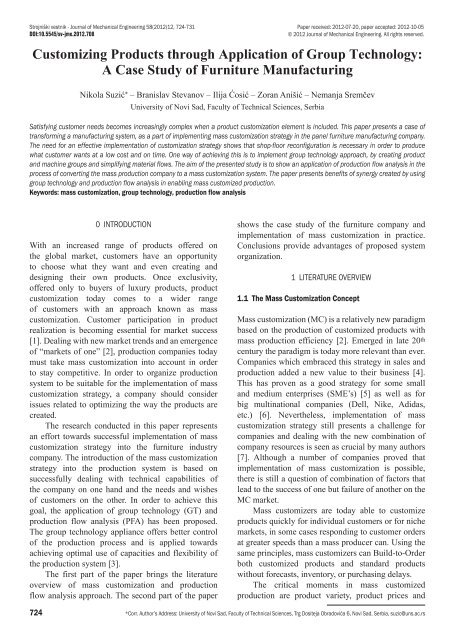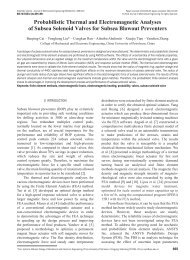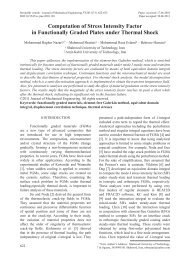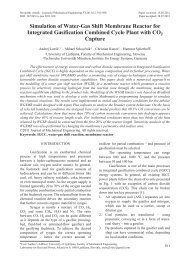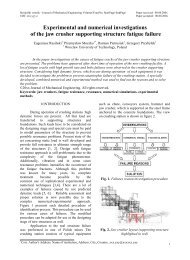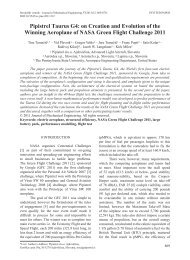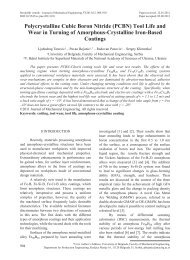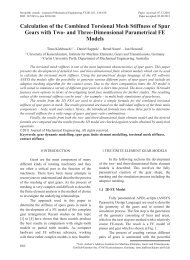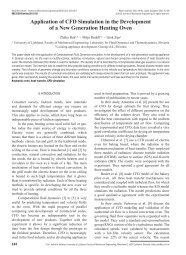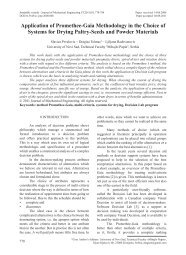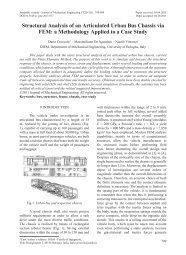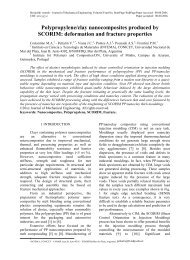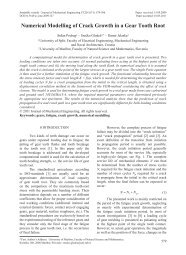Customizing Products through Application of Group Technology: A ...
Customizing Products through Application of Group Technology: A ...
Customizing Products through Application of Group Technology: A ...
Create successful ePaper yourself
Turn your PDF publications into a flip-book with our unique Google optimized e-Paper software.
Strojniški vestnik - Journal <strong>of</strong> Mechanical Engineering 58(2012)12, 724-731 Paper received: 2012-07-20, paper accepted: 2012-10-05<br />
DOI:10.5545/sv-jme.2012.708<br />
© 2012 Journal <strong>of</strong> Mechanical Engineering. All rights reserved.<br />
<strong>Customizing</strong> <strong>Products</strong> <strong>through</strong> <strong>Application</strong> <strong>of</strong> <strong>Group</strong> <strong>Technology</strong>:<br />
A Case Study <strong>of</strong> Furniture Manufacturing<br />
Suzić, N. – Stevanov, B. – Ćosić, I. – Anišić, Z. – Sremčev, N.<br />
Nikola Suzić * – Branislav Stevanov – Ilija Ćosić – Zoran Anišić – Nemanja Sremčev<br />
University <strong>of</strong> Novi Sad, Faculty <strong>of</strong> Technical Sciences, Serbia<br />
Satisfying customer needs becomes increasingly complex when a product customization element is included. This paper presents a case <strong>of</strong><br />
transforming a manufacturing system, as a part <strong>of</strong> implementing mass customization strategy in the panel furniture manufacturing company.<br />
The need for an effective implementation <strong>of</strong> customization strategy shows that shop-floor reconfiguration is necessary in order to produce<br />
what customer wants at a low cost and on time. One way <strong>of</strong> achieving this is to implement group technology approach, by creating product<br />
and machine groups and simplifying material flows. The aim <strong>of</strong> the presented study is to show an application <strong>of</strong> production flow analysis in the<br />
process <strong>of</strong> converting the mass production company to a mass customization system. The paper presents benefits <strong>of</strong> synergy created by using<br />
group technology and production flow analysis in enabling mass customized production.<br />
Keywords: mass customization, group technology, production flow analysis<br />
0 INTRODUCTION<br />
With an increased range <strong>of</strong> products <strong>of</strong>fered on<br />
the global market, customers have an opportunity<br />
to choose what they want and even creating and<br />
designing their own products. Once exclusivity,<br />
<strong>of</strong>fered only to buyers <strong>of</strong> luxury products, product<br />
customization today comes to a wider range<br />
<strong>of</strong> customers with an approach known as mass<br />
customization. Customer participation in product<br />
realization is becoming essential for market success<br />
[1]. Dealing with new market trends and an emergence<br />
<strong>of</strong> “markets <strong>of</strong> one” [2], production companies today<br />
must take mass customization into account in order<br />
to stay competitive. In order to organize production<br />
system to be suitable for the implementation <strong>of</strong> mass<br />
customization strategy, a company should consider<br />
issues related to optimizing the way the products are<br />
created.<br />
The research conducted in this paper represents<br />
an effort towards successful implementation <strong>of</strong> mass<br />
customization strategy into the furniture industry<br />
company. The introduction <strong>of</strong> the mass customization<br />
strategy into the production system is based on<br />
successfully dealing with technical capabilities <strong>of</strong><br />
the company on one hand and the needs and wishes<br />
<strong>of</strong> customers on the other. In order to achieve this<br />
goal, the application <strong>of</strong> group technology (GT) and<br />
production flow analysis (PFA) has been proposed.<br />
The group technology appliance <strong>of</strong>fers better control<br />
<strong>of</strong> the production process and is applied towards<br />
achieving optimal use <strong>of</strong> capacities and flexibility <strong>of</strong><br />
the production system [3].<br />
The first part <strong>of</strong> the paper brings the literature<br />
overview <strong>of</strong> mass customization and production<br />
flow analysis approach. The second part <strong>of</strong> the paper<br />
shows the case study <strong>of</strong> the furniture company and<br />
implementation <strong>of</strong> mass customization in practice.<br />
Conclusions provide advantages <strong>of</strong> proposed system<br />
organization.<br />
1 LITERATURE OVERVIEW<br />
1.1 The Mass Customization Concept<br />
Mass customization (MC) is a relatively new paradigm<br />
based on the production <strong>of</strong> customized products with<br />
mass production efficiency [2]. Emerged in late 20 th<br />
century the paradigm is today more relevant than ever.<br />
Companies which embraced this strategy in sales and<br />
production added a new value to their business [4].<br />
This has proven as a good strategy for some small<br />
and medium enterprises (SME’s) [5] as well as for<br />
big multinational companies (Dell, Nike, Adidas,<br />
etc.) [6]. Nevertheless, implementation <strong>of</strong> mass<br />
customization strategy still presents a challenge for<br />
companies and dealing with the new combination <strong>of</strong><br />
company resources is seen as crucial by many authors<br />
[7]. Although a number <strong>of</strong> companies proved that<br />
implementation <strong>of</strong> mass customization is possible,<br />
there is still a question <strong>of</strong> combination <strong>of</strong> factors that<br />
lead to the success <strong>of</strong> one but failure <strong>of</strong> another on the<br />
MC market.<br />
Mass customizers are today able to customize<br />
products quickly for individual customers or for niche<br />
markets, in some cases responding to customer orders<br />
at greater speeds than a mass producer can. Using the<br />
same principles, mass customizers can Build-to-Order<br />
both customized products and standard products<br />
without forecasts, inventory, or purchasing delays.<br />
The critical moments in mass customized<br />
production are product variety, product prices and<br />
724<br />
*Corr. Author’s Address: University <strong>of</strong> Novi Sad, Faculty <strong>of</strong> Technical Sciences, Trg Dositeja Obradovića 6, Novi Sad, Serbia, suzic@uns.ac.rs
Strojniški vestnik - Journal <strong>of</strong> Mechanical Engineering 58(2012)12, 724-731<br />
period <strong>of</strong> the product delivery. These are factors<br />
relevant to the solution space mentioned by Piller and<br />
Tseng [8], which is to be determined by the production<br />
company. The variety <strong>of</strong> customized production is<br />
based on product families, modular or scaled, and<br />
product platforms, created either with top-down or<br />
bottom-up approach [9].<br />
MC production is supported by configuration<br />
tools, either online (external) or <strong>of</strong>fline (internal) [10].<br />
The configuration tools enable the full capacity <strong>of</strong><br />
mass customization and with usage <strong>of</strong> a good customer<br />
database can lead to enhanced customer loyalty [9].<br />
In the work <strong>of</strong> Fain et al. [11] the important role <strong>of</strong><br />
the user in product development is emphasized.<br />
Furthermore, dealing with an optimal number <strong>of</strong><br />
product variants becomes an important task <strong>of</strong> design<br />
process in production company [12].<br />
The mass customized production is in practice<br />
realized with flexible production systems [13] able<br />
to deal with a variety <strong>of</strong> manufactured parts and<br />
adjustable assembly operations. In order to embrace<br />
mass customization production companies must<br />
determine the depth <strong>of</strong> the customization [14] which<br />
is suitable for company’s level <strong>of</strong> technology. In order<br />
to be successful in MC production a company must<br />
be successful in designing products, the marketing <strong>of</strong><br />
products, create a functional configuration process<br />
and configuration tool, but first <strong>of</strong> all it should have<br />
a production configured in a way that can support the<br />
needs for product variety and individual orders.<br />
1.2 <strong>Group</strong> <strong>Technology</strong><br />
<strong>Group</strong> technology is an approach to production system<br />
organization which has existed for many decades.<br />
<strong>Group</strong> technology first appeared in the book <strong>of</strong><br />
Mitr<strong>of</strong>anov [15]. GT is based on the idea <strong>of</strong> grouping<br />
parts by using similarity. The approach results with<br />
cellular organization <strong>of</strong> machines in production<br />
systems [16] and [17]. This approach gave many<br />
benefits to solving problems like long lead times, large<br />
setup times, increased Work-In-Progress inventories,<br />
large inventories <strong>of</strong> finished goods, poor part quality<br />
and high unit costs, as shown in Wemmerlöv and Hyer<br />
[18] and in Wemmerlöv and Johnson [19].<br />
<strong>Group</strong>ing <strong>of</strong> parts can be achieved in several ways,<br />
firstly <strong>through</strong> finding similarities in part geometry by<br />
using classification and coding system (C&C), but<br />
this method is not always the most suitable. Burbidge<br />
[20] indicates several reasons which make the use<br />
<strong>of</strong> classification and coding system unsatisfactory.<br />
Such reasons lie in the facts that C&C system does<br />
not group machines, it also tends to group parts made<br />
<strong>of</strong> different materials and size, and is time consuming<br />
and complex. <strong>Group</strong>ing <strong>of</strong> parts can also be done by<br />
using part drawings which is known as the visual<br />
inspection method. This method is hardly practical<br />
as the part number grows. Another way <strong>of</strong> part group<br />
creation is by finding same processing technology<br />
steps that are shared by parts. Parts that have the same<br />
technological operations can be grouped together. This<br />
method is known as PFA which has been developed<br />
by John. L. Burbidge [21] and [22]. PFA consists <strong>of</strong><br />
several phases which include an analysis <strong>of</strong> material<br />
flow in the production system, forming part families<br />
and machine groups, analysis <strong>of</strong> material flows within<br />
cells and analysis <strong>of</strong> tools concerning the setup time<br />
reduction criteria. Several cases indicate the benefits<br />
<strong>of</strong> implementation <strong>of</strong> PFA and can be found in<br />
Wemmerlöv and Johnson [19] and [23], in Lee et al.<br />
Fig. 1. Shop-floor process layout<br />
<strong>Customizing</strong> <strong>Products</strong> <strong>through</strong> <strong>Application</strong> <strong>of</strong> <strong>Group</strong> <strong>Technology</strong>: A Case Study <strong>of</strong> Furniture Manufacturing<br />
725
Strojniški vestnik - Journal <strong>of</strong> Mechanical Engineering 58(2012)12, 724-731<br />
[24], in Ribeiro and de Araújo [25] and Hameri [26].<br />
PFA has proven itself as a simple and efficient method<br />
to achieve cellular manufacturing organization.<br />
2 CASE STUDY OF FURNITURE MANUFACTURING<br />
2.1 Shop-Floor<br />
For the purposes <strong>of</strong> research a furniture production<br />
company was chosen. The chosen company produces<br />
panel furniture on mass production scale. Company<br />
produces 440 different products, such as wardrobes,<br />
beds, kitchen cabinets and all kinds <strong>of</strong> smaller pieces<br />
<strong>of</strong> furniture for the household. Shop-floor process<br />
layout with transport routes is given in Fig. 1.<br />
Production starts with the cutting <strong>of</strong> basic shapes<br />
<strong>of</strong> wood panels for future product parts. The cutting<br />
operation consists <strong>of</strong> two cutting machines. The next<br />
phase <strong>of</strong> production is edge finishing which contains<br />
three distinctive machines for edge finishing. All three<br />
machines have different production and technology<br />
capabilities. Next, parts go to the drilling operation<br />
which contains three machines. Further into the<br />
process, two CNC centers are used for complex shapes<br />
<strong>of</strong> parts. The production process is finalized with<br />
visual control <strong>of</strong> parts, final control and packaging.<br />
Special machining is done on some parts where<br />
special features, such as mirrors for an example, are<br />
assembled on them.<br />
2.2 Market Research<br />
In order to determine the percents <strong>of</strong> customers<br />
who want customized products, market research is<br />
conducted. The goal <strong>of</strong> the research was to reveal the<br />
potentials <strong>of</strong> furniture market in the province in Serbia.<br />
For the purposes <strong>of</strong> the research a questionnaire was<br />
composed. Main subjects <strong>of</strong> the research included:<br />
• Location <strong>of</strong> participants (showing geographical<br />
area in percents).<br />
• Pr<strong>of</strong>ile <strong>of</strong> participants (by gender, age, place <strong>of</strong><br />
living and size <strong>of</strong> settlement).<br />
• Preferences <strong>of</strong> furniture buyers (whether they<br />
plan to buy small or large pieces <strong>of</strong> panel or<br />
stylish furniture, or both kinds equally).<br />
• Experiences with previous purchase <strong>of</strong> furniture<br />
(where do buyers most frequently go to buy the<br />
furniture, and how <strong>of</strong>ten does it happen that the<br />
<strong>of</strong>fer <strong>of</strong> standard furniture does not match their<br />
needs).<br />
• Properties <strong>of</strong> standard furniture <strong>of</strong>fer that<br />
customers marked as inadequate (by color,<br />
dimensions, quality and functionality).<br />
• Significance <strong>of</strong> customization to customers<br />
(whether they would like to have the option to<br />
customize their furniture during next purchase).<br />
• Readiness <strong>of</strong> paying more and waiting longer for<br />
customized furniture.<br />
• Internet usage and readiness to use the web in<br />
order to customize furniture.<br />
The research has shown that:<br />
• The given market is oriented on panel furniture<br />
(63%).<br />
• Furniture stores are the place where most buyers<br />
purchase their furniture (67%). If the buyer would<br />
not find what they were looking for they would<br />
go to a craftsman (carpenter). Only every tenth<br />
buyer goes directly to a carpenter.<br />
• Dimensions (40%) and functional characteristics<br />
(48%) <strong>of</strong> furniture are the main properties with<br />
which customers were not satisfied in their past<br />
purchases. Mass customization can meet these<br />
needs very successfully.<br />
• Majority <strong>of</strong> buyers (60%) would like to have the<br />
opportunity to change properties <strong>of</strong> furniture, and<br />
33.3% more would like to have that option even if<br />
it would not mean a lot to them.<br />
• The population <strong>of</strong> internet users in the region<br />
is satisfying (82%), and furthermore most <strong>of</strong><br />
them (70.7%) would be ready to customize their<br />
furniture over the Internet.<br />
The research has shown that there is a group <strong>of</strong><br />
potential buyers <strong>of</strong> customized furniture ready to pay<br />
more and wait longer just to get a product that better<br />
fits their needs. Research has also shown that customer<br />
needs are not always met with standard panel furniture<br />
<strong>of</strong>fer.<br />
The need to embrace and implement mass<br />
customization has been recognized by company<br />
management. The first step in this process was to find<br />
a way to organize production system in a way which<br />
can support customization.<br />
2.3 System Analysis<br />
The analysis <strong>of</strong> the system was done <strong>through</strong> several<br />
steps which consist <strong>of</strong> analysis <strong>of</strong> product assortment,<br />
machine line-up, material flow, as well as the<br />
technological capabilities <strong>of</strong> the machines.<br />
This company is not a complex system in terms <strong>of</strong><br />
PFA, so the company flow analysis was not necessary.<br />
The analysis started with factory flow analysis (FFA).<br />
The whole product assortment <strong>of</strong> 440 products<br />
was analyzed part by part. Every product and product<br />
part needs to be compared with similar products and<br />
parts from the production assortment. Similarities<br />
726 Suzić, N. – Stevanov, B. – Ćosić, I. – Anišić, Z. – Sremčev, N.
Strojniški vestnik - Journal <strong>of</strong> Mechanical Engineering 58(2012)12, 724-731<br />
can be found in the attributes <strong>of</strong> material (such as<br />
thickness and color for example), the quality <strong>of</strong><br />
material and compatibility <strong>of</strong> parts embedded into<br />
multiple products.<br />
The product assortment was analyzed manually<br />
by using product explosion and parts material<br />
flow (production technology specifications). The<br />
production program is wide, but is mostly made up<br />
<strong>of</strong> parts that have similar processing. Fig. 2 shows<br />
a chosen example <strong>of</strong> five products from product<br />
assortment: the horizontal dresser, the wardrobe, the<br />
shelves, the vertical dresser and the computer table.<br />
The whole product assortment is produced on a<br />
number <strong>of</strong> machines shown in Table 1.<br />
which can have different thickness. Decomposing <strong>of</strong><br />
440 products led to the creation <strong>of</strong> 16 distinct part<br />
groups shown in Fig. 3, red represents processing<br />
done on each part group. The production process <strong>of</strong><br />
the part groups, according to the routing can be seen<br />
in Table 2.<br />
Table 1. The machine list<br />
Machine<br />
Machine name<br />
number<br />
1 Cutting machine<br />
2 One side edging machine<br />
3 Two side edging machine with gutter making option<br />
4 Two side edging machine<br />
5 Two side edging machine<br />
6 Drilling machine<br />
7 Drilling machine<br />
8 Drilling machine<br />
Multi-purpose machining center (drilling, cutting and<br />
9<br />
trimming)<br />
10 Drilling machining center<br />
11* Visual control <strong>of</strong> parts and manual finishing<br />
12* Final control <strong>of</strong> products<br />
13* + Special machining<br />
14* Packaging<br />
* The numbers 11, 12, 13 and 14 represent the part operations done<br />
after the processing.<br />
+ Special machining is done on some <strong>of</strong> the product parts (parts with<br />
mirrors, printing, etc.).<br />
Fig. 2. The example <strong>of</strong> the product assortment part analysis<br />
2.4 Creation <strong>of</strong> Product Part <strong>Group</strong>s<br />
Based on production technology, available machines<br />
and analysis <strong>of</strong> product parts the part groups were<br />
created. During the creation <strong>of</strong> the part groups,<br />
several things were taken into account, like the work<br />
operations that are needed to be performed on the<br />
machines, the efficiency <strong>of</strong> the machines and the sizes<br />
<strong>of</strong> the parts which are produced. The parts which, at<br />
a first glance, have very similar (almost identical)<br />
production technology specifications are classified<br />
into different groups because <strong>of</strong> their size (small,<br />
medium and big). All the parts are made <strong>of</strong> plywood,<br />
Fig. 3. Derived part groups<br />
<strong>Customizing</strong> <strong>Products</strong> <strong>through</strong> <strong>Application</strong> <strong>of</strong> <strong>Group</strong> <strong>Technology</strong>: A Case Study <strong>of</strong> Furniture Manufacturing<br />
727
Strojniški vestnik - Journal <strong>of</strong> Mechanical Engineering 58(2012)12, 724-731<br />
Table 2. Routing <strong>of</strong> part groups<br />
Part group<br />
<strong>Technology</strong> sequence*<br />
1 1<br />
2 1-3<br />
3 1-3-6<br />
4 1-4-6<br />
5 1-5-6<br />
6 1-5-7<br />
7 1-4-6<br />
8 1-4-10<br />
9 1-3-9<br />
10 1-3-6<br />
11 1-8<br />
12 1-9<br />
13 1-3-4-6<br />
14 1-2-4-6<br />
15 1-2-4-6<br />
16 1-2-6<br />
*The technology numbers correspond to the previously given machine<br />
list in Table 1.<br />
Obtained part groups as well as their routing and<br />
available machines in the system led to the creation <strong>of</strong><br />
material flow diagram for part groups Fig. 4.<br />
Fig. 4. Material flow diagram for part groups<br />
*There are two cutting machines in the production system. In the next matrix they will be presented separately as 1a and 1b cutting machines.<br />
Fig. 5. The starting matrix<br />
Fig. 6. Resulting incidence matrix - Division into machine groups<br />
728 Suzić, N. – Stevanov, B. – Ćosić, I. – Anišić, Z. – Sremčev, N.
Strojniški vestnik - Journal <strong>of</strong> Mechanical Engineering 58(2012)12, 724-731<br />
2.5 Incidence Matrix (Clustering Analysis)<br />
According to PFA methodology, the starting matrix<br />
with machines and part groups is given in Fig. 5.<br />
are treated in this way, so there was no need for tool<br />
scheduling in the cells.<br />
2.6 Cell Formation<br />
In this initial setting part groups are assigned to<br />
machines according to routing criteria. However,<br />
some machines are capable <strong>of</strong> processing other part<br />
groups, for example all drilling machines are able<br />
to process all <strong>of</strong> the required parts. This means that<br />
the rotation <strong>of</strong> machines is a possible option for cell<br />
formation. In Fig. 6 the resulting incidence matrix is<br />
given. It shows that two cells can be formed with no<br />
exceptions in the cell formation.<br />
In the process <strong>of</strong> cell formation some machines<br />
were replaced by equivalent machines capable <strong>of</strong><br />
processing the given part groups. The replacement<br />
is done in groups 4, 7 and 8 which are moved from<br />
machine number 4 to machine number 5. Also, part<br />
groups number 4, 5 and 7 are moved from machine<br />
number 6 to machine number 7. Replacement from<br />
one machine to another was done with the intention<br />
<strong>of</strong> creating unraveled material flows, thus enabling<br />
the creation <strong>of</strong> the separate material flows and<br />
manufacturing cells. The replacement was done<br />
without a significant impact on machining time<br />
and machine efficiency since the characteristics <strong>of</strong><br />
drilling machines are comparable and plywood parts<br />
are done with similar technology. On the other hand,<br />
the intention was to create notable savings in lead<br />
times with cellular organization. Lead times <strong>of</strong> parts<br />
are not affected with the machine changes since they<br />
will not considerably differ. On the other hand, lead<br />
times are impacted greatly by a significant decrease<br />
<strong>of</strong> unfinished production and queues brought by new<br />
production organization. This way, the forming <strong>of</strong><br />
two distinct manufacturing cells is enabled (one cell<br />
for complex parts and the other one for less complex<br />
parts). Cells are created with no additional costs.<br />
Material flow diagram for these two cells is shown in<br />
Fig. 7.<br />
The FROM/TO matrices for two cells are shown<br />
in Fig. 8. The matrices show that there are no returning<br />
flows in the production system organized this way.<br />
Tooling analysis (TA) as the part <strong>of</strong> PFA was not<br />
conducted because <strong>of</strong> the nature <strong>of</strong> manufacturing<br />
technology. In the panel furniture industry tools have<br />
a high level <strong>of</strong> standardization and unification; for<br />
example, drills used for shelf positioning are equal for<br />
all the products that company makes. All tool types<br />
a)<br />
Fig. 7. Material flow diagram for cells<br />
b)<br />
Fig. 8. FROM/TO matrices <strong>of</strong> manufacturing cells;<br />
a) for manufacturing cell 1, b) for manufacturing cell 2<br />
3 CONCLUSIONS<br />
Mass customization production environment has<br />
evolved over the past two decades. It has developed<br />
in theory and as an industrial practice. In this<br />
paper, the presented research, theoretical as well as<br />
<strong>Customizing</strong> <strong>Products</strong> <strong>through</strong> <strong>Application</strong> <strong>of</strong> <strong>Group</strong> <strong>Technology</strong>: A Case Study <strong>of</strong> Furniture Manufacturing<br />
729
Strojniški vestnik - Journal <strong>of</strong> Mechanical Engineering 58(2012)12, 724-731<br />
Fig. 9. Reconfiguration <strong>of</strong> shop-floor<br />
that conducted in the industry, showed that mass<br />
customization is possible to achieve by implementing<br />
GT philosophy.<br />
Implementation <strong>of</strong> GT principles <strong>through</strong> analysis<br />
<strong>of</strong> the system has led to a new layout presented in Fig.<br />
9. Shop-floor has been divided into three work units:<br />
• Manufacturing cell 1 – for production <strong>of</strong> complex<br />
parts.<br />
• Manufacturing cell 2 – for production <strong>of</strong> simple<br />
parts.<br />
• Area for packaging and commissioning <strong>of</strong><br />
modules.<br />
This lead to increased effects in the sense <strong>of</strong>:<br />
• decreasing the set-up times (a decrease from 3 up<br />
to 10 times, depending on the machine),<br />
• simplifying the material flows in the system,<br />
• simplifying the launch <strong>of</strong> orders into the system,<br />
• shortening the lead times in the system (from 8 up<br />
to 12 times depending on the concrete part),<br />
• shortening transport ways and with it the transport<br />
times in the system (approx. twice),<br />
• decreasing the size <strong>of</strong> unfinished production and<br />
queues between the operations significantly.<br />
However, full transformation from mass<br />
production to mass customization system cannot<br />
only rely on GT and does not end with shop floor<br />
transformation. Manufacturing cells are only the first<br />
step, and they enable better organization <strong>of</strong> production<br />
system. Having that in mind, in conclusion we propose<br />
the development <strong>of</strong> several systems (mainly s<strong>of</strong>tware<br />
oriented) for mass customization:<br />
• web enabled product configuration tool, so<br />
that customers can configure its products in the<br />
meaning <strong>of</strong> choosing the material, customizing<br />
design and choosing special features,<br />
• implementation <strong>of</strong> ERP and PDM/PLM systems<br />
for an easier understanding <strong>of</strong> customer<br />
needs, product and process data management,<br />
information sharing and collaboration, analyses<br />
and corrective measures [27],<br />
• the development <strong>of</strong> s<strong>of</strong>tware solution for part<br />
groups creation and scheduling in a customized<br />
production environment,<br />
• RFID part tagging, so that every part can be<br />
tracked <strong>through</strong>out its “life” in a shop floor, and<br />
in the warehouse,<br />
• different manufacturing process execution<br />
scenarios simulation [29] and [30], for the<br />
prediction <strong>of</strong> possible problems and the<br />
evaluation <strong>of</strong> solutions,<br />
• integration <strong>of</strong> previously mentioned tools<br />
and systems <strong>through</strong> heavy use <strong>of</strong> XML data<br />
representation, a similar solution can be found in<br />
the work <strong>of</strong> Šormaz et al. [28].<br />
4 REFERENCES<br />
[1] Rihar, L., Kušar, J., Duhovnik, J., Starbek, M. (2010).<br />
Teamwork as a precondition for simultaneous product<br />
realization. Concurrent Engineering: Research and<br />
<strong>Application</strong>s, vol. 18, no. 4, p. 261-273.<br />
[2] Davis, S.M. (1987). Future Perfect, Addison-Wesley<br />
Publishing Company, New York.<br />
[3] Morača, S., Hadžistević, M., Drstvenšek, I., Radaković,<br />
N. (2010). <strong>Application</strong> <strong>of</strong> group technology in complex<br />
cluster type organizational systems, Strojniški vestnik -<br />
Journal <strong>of</strong> Mechanical Engineering, vol. 56, no. 10, p.<br />
663-675<br />
[4] Gilmore, J.H., Pine, J.B. (1997). The Four Faces:<br />
Customization, Harvard Business Review, no. 75, p. 91-<br />
101<br />
[5] Piller, F. (2004). Mass customization: Reflections on the<br />
state <strong>of</strong> the concept. The International Journal <strong>of</strong> Flexible<br />
Manufacturing Systems, vol. 16, no. 4, p. 313-334,<br />
DOI:10.1007/s10696-005-5170-x.<br />
730 Suzić, N. – Stevanov, B. – Ćosić, I. – Anišić, Z. – Sremčev, N.
Strojniški vestnik - Journal <strong>of</strong> Mechanical Engineering 58(2012)12, 724-731<br />
[6] Salvador, F., De Holan, P.M., Piller, F. (2009).<br />
Cracking the code <strong>of</strong> mass customization. MIT Sloan<br />
Management Review, vol. 50, no. 3, p. 71-78.<br />
[7] Borocki, J., Ćosić, I., Lalić, B., Maksimović, R.<br />
(2011). Analysis <strong>of</strong> company development factors<br />
in manufacturing and service company: a strategic<br />
approach. Strojniški vestnik - Journal <strong>of</strong> Mechanical<br />
Engineering, vol. 57, no. 1, p. 55-68, DOI:10.5545/svjme.2010.030.<br />
[8] Piller, F.T., Tseng, M. (2003). The Customer Centric<br />
Enterprise: Advances in Mass Customization and<br />
Personalization, Springer, New York/Berlin.<br />
[9] Simpson, T.W., Maier, J.R.A, Mistree, F. (2001). Product<br />
platform design: Method and aplication. Research in<br />
Engineering Design, vol. 13, p. 2-22, DOI:10.1007/<br />
s001630100002.<br />
[10] Blecker, T., Abdelkafi, N., Kreuter, G., Friedrich, G.<br />
(2004). Product configuration systems: state-<strong>of</strong>-theart,<br />
conceptualization and extensions. 8 th Maghrebian<br />
Conference on S<strong>of</strong>tware Engineering and Artificial<br />
Intelligence, vol. 2, p. 25-36.<br />
[11] Fain, N., Moes, N., Duhovnik, J. (2010). The role <strong>of</strong><br />
the user and the society in new product development.<br />
Strojniški vestnik - Journal <strong>of</strong> Mechanical Engineering,<br />
vol. 56, no. 7-8, p. 521-530.<br />
[12] Anišić, Z., Krsmanović, C. (2008). Assembly initiated<br />
production as a prerequisite for mass customization and<br />
effective manufacturing. Strojniški vestnik - Journal <strong>of</strong><br />
Mechanical Engineering, vol. 54, no. 9, p. 607-618.<br />
[13] Koren, Y. (2010). The Global Manufacturing<br />
Revolution – Product-Process-Business Integration and<br />
Reconfigurable Systems, John Wiley & Sons, Hoboken,<br />
DOI:10.1002/9780470618813.<br />
[14] Lampel, J., Mintzberg, H. (1996). <strong>Customizing</strong><br />
Customization. Sloan Management Review, vol. 38, no.<br />
1, p. 21-30.<br />
[15] Mitr<strong>of</strong>anov, S.P. (1966). Scientific Principles <strong>of</strong> <strong>Group</strong><br />
<strong>Technology</strong>, (english translation), National Library for<br />
Science and <strong>Technology</strong>, Washington, DC (originally<br />
published in 1959).<br />
[16] Zelenović, D., Burbidge, L.J., Ćosić, I., Maksimović, R.<br />
(1995). The division <strong>of</strong> large complex production systems,<br />
into independent, autonomous units. Proceeding <strong>of</strong> 13 th<br />
International Conference <strong>of</strong> Production Research, ICPR,<br />
Global Frontiers in Manufacturing, Jerusalem, p. 213-<br />
215.<br />
[17] Zelenović, D., Ćosić, I., Maksimović, R. (1998). Design and<br />
reengineering <strong>of</strong> production systems: Yugoslavian (IISE)<br />
approaches. Monograph <strong>Group</strong> <strong>Technology</strong> and Cellular<br />
Manufacturing - State <strong>of</strong>-The-Art Synthesis <strong>of</strong> Research and<br />
Practice, Kluwer Academic Publishers, vol. 16, p. 517-537,<br />
New York.<br />
[18] Wemmerlöv, U., Hyer, N.L. (1989). Cellular<br />
manufacturing in the U.S. industry: A survey <strong>of</strong> users.<br />
International Journal <strong>of</strong> Production Research, vol. 27, no.<br />
7, p. 1511-1530, DOI:10.1080/00207548908942637.<br />
[19] Wemmerlöv, U., Johnson, D.J. (1997). Cellular<br />
manufacturing at 46 user plants: implementation<br />
experiences and performance improvements. International<br />
Journal <strong>of</strong> Production Research, vol. 35, no. 1, p. 29-49,<br />
DOI:10.1080/002075497195966.<br />
[20] Burbidge, J.L. (1989). Production Flow Analysis for<br />
Planning <strong>Group</strong> <strong>Technology</strong>. Oxford University Press,<br />
Oxford.<br />
[21] Burbidge, J.L. (1961). The new approach to production.<br />
Production Engineer, vol. 40, no. 12, p. 769-793,<br />
DOI:10.1049/tpe.1961.0104.<br />
[22] Burbidge, J.L. (1963). Production flow analysis.<br />
Production Engineer, vol. 42, no. 12, p. 742-752,<br />
DOI:10.1049/tpe.1963.0114.<br />
[23] Wemmerlöv, U., Johnson, D.J. (2000). Empirical findings<br />
on manufacturing cell design. International Journal<br />
<strong>of</strong> Production Research, vol. 38, no. 3, p. 481-507,<br />
DOI:10.1080/002075400189275.<br />
[24] Lee, H.L., Padmanabhan, V., Whang, S. (1997).<br />
Information distortion in supply chain: the bullwhip<br />
effect. Management science, vol. 43, no. 4, p. 546-558,<br />
DOI:10.1287/mnsc.43.4.546.<br />
[25] Dos Santos, N.R., De Araújo Jr., L.O. (2003).<br />
Computational system for group technology – PFA case<br />
study. Integrated Manufacturing Systems, vol. 14, no. 2, p.<br />
138-152, DOI:10.1108/09576060310459438.<br />
[26] Hameri, A.-P. (2011). Production flow analysis—cases<br />
from manufacturing and service industry. International<br />
Journal <strong>of</strong> Production Economics, vol. 129, no. 2, p. 233-<br />
241, DOI:10.1016/j.ijpe.2010.10.015.<br />
[27] Kušar, J., Rihar, L., Duhovnik, J., Starbek, M. (2008).<br />
Project management <strong>of</strong> product development. Strojniški<br />
vestnik - Journal <strong>of</strong> Mechanical Engineering, vol. 54, no.<br />
9, p. 588-606.<br />
[28] Šormaz, D.N., Arumugam, J., Harihara, R.S., Patel, C.,<br />
Neerukonda, N. (2010). Integration <strong>of</strong> product design,<br />
process planning, scheduling, and FMS control using XML<br />
data representation. Robotics and Computer-Integrated<br />
Manufacturing, vol. 26, no. 6, p. 583-595, DOI:10.1016/j.<br />
rcim.2010.07.014.<br />
[29] Reddy, B.S.P., Rao, C.S.P. (2011). Flexible<br />
manufacturing systems modelling and performance<br />
evaluation using AutoMod. International Journal<br />
<strong>of</strong> Simulation Modelling, vol. 10, no. 2, p. 78-90,<br />
DOI:10.2507/IJSIMM10(2)3.176.<br />
[30] Lokesh, K., Jain, P. K. (2010). Concurrently part-machine<br />
groups formation with important production data.<br />
International Journal <strong>of</strong> Simulation Modelling, vol. 9, no. 1,<br />
p. 5-16, DOI:10.2507/IJSIMM09(1)1.133.<br />
<strong>Customizing</strong> <strong>Products</strong> <strong>through</strong> <strong>Application</strong> <strong>of</strong> <strong>Group</strong> <strong>Technology</strong>: A Case Study <strong>of</strong> Furniture Manufacturing<br />
731


